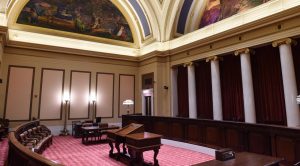
Unionized Science Museum workers await contract as cultural nonprofits face changing labor market
When the newly-unionized workers at the Science Museum of Minnesota host a public rally Tuesday to urge progress toward their first contract, it will be the culmination of more than three years of organizing one of the lesser-known labor efforts in the Twin Cities.
Employees say they’ve had to lobby their peers over objection from museum management. Museum officials contend they’ve faced significant hurdles of their own. Four years after the onset of the pandemic, visitor attendance has yet to surpass 80% of pre-pandemic levels. What was once a $42 million annual operating budget dropped to about $32 million in the time of social distancing, and has just climbed back up to $38 million.
“I’d like it to be faster,” said Juliette Francis, vice president of mission advancement for the museum, noting attendance at zoos, botanical gardens and other institutions offering outdoor activities has generally picked up more quickly. “We’re all trying to navigate t
his new world that we’re in.”
Labor vote
More than 200 of the museum’s nearly 400 staff members were incorporated last year into a “wall-to-wall” labor unit that includes both public-facing staff and behind-the-scenes personnel. For members, the process was at times a literal slog: Up to 19 inches of heavy snow had fell in parts of the Twin Cities when employees voted, in person, 79 to 50 to join AFSCME Council 5 on Jan. 6 of last year. Management of the 117-year-old St. Paul institution had insisted upon an in-person vote, as opposed to mail-in ballots.
“Management contested about 27 people’s roles,” recalled Gretchen Haupt, a union steward and research and evaluation associate in the Science Museum’s visitor studies department. “For most of our marketing and most of our community outreach department, they challenged their eligibility.”
Over a year later, the eligibility questions remain unresolved, as does the union’s first contract and questions over unfulfilled back-pay for a group of terminated employees.
‘A burgeoning cultural workers sector’
Inspired in part by pandemic-era lay-offs, as well as record inflation, Twin Cities labor movements have seen an uptick in mobilization. Janitors, school teachers, university graduate students, plow truck operators, firefighters, nurses, rideshare drivers and coffeeshop baristas have all recently taken their arguments for better pay and working conditions to the public picket line, or threatened to.
Museums have had a lower-profile in those labor efforts, but workers at the Minnesota Historical Society in St. Paul, Walker Arts Center in Minneapolis and Science Museum all have unionized in the past four years with the goal of collective bargaining for employee-friendly contracts.
Most of the Science Museum’s workers were laid off and sent home when the pandemic forced closures in March 2020, only to be gradually called back months later into a climate marked by social distancing and general uncertainty. Hazard pay for frontline staff in visitor services disappeared after a few months. Workers rallied and got it back.
“We had a number of wins as non-organized staff, and those wins led to talking about ‘What could we do if we were organized?’” said former employee Natalie Naranjo, in an interview Wednesday.
Similar stories have played out across public-facing cultural institutions, from libraries to history centers. According to the Union Membership and Coverage Database, about 11% of workers at museums, art galleries and history centers are unionized.
“There’s a burgeoning culture workers sector,” said Haupt, who returned to the museum in September 2020 after being sidelined for nearly six months. “There were no vaccines yet. Things were changing week by week, and there was a lot of staff feeling underheard and underpaid. The public-facing staff was feeling really disadvantaged. There was a lot of lack of transparency around things like discipline and what would get you in trouble.”
New dimensions
At the same time, racial unrest, among other issues, have added new dimensions to the labor movement. Many major institutions pledged a deeper commitment to equity after the May 2020 murder of George Floyd, a Black man, by a Minneapolis Police officer. Workers said they plan to hold them to it.
In addition to emphasizing collaboration and learning, the Science Museum’s values statement was updated a few years before the pandemic to read: “Equity. We reject oppressive norms and practice authentic inclusion to achieve collective liberation.” How that plays out in the workplace can be touch and go.
“As the Science Museum has pushed to live its equity and access (mission), and to really frontline and platform that, the staff were attracted to an extremely passion-driven and mission-driven field,” said Haupt, noting most employees enjoy a high level of satisfaction with their work. “There’s an incredibly high bar for what internal culture should be like. I don’t think this is unique to the Science Museum, but with the pandemic, people realized the status quo wasn’t cemented.”
Organizers take case to the NLRB
Exactly two months after the museum workers’ unionization vote, on March 6 of last year, the Science Museum announced it would lay off 15 employees due to budget pressures. The lay-offs eliminated 13 union positions, including several individuals who had been vocal labor organizers.
The union fought the lay-offs by taking their case to the National Labor Relations Board, which found merit in their complaint and recommended any lay-offs be negotiated. Not all chose to return, but six workers were reinstated in August 2023, effectively on-call with no work to do. Rather than report to their former supervisors, they answered to a manager in Human Resources, whom they never met.
“They were in what we called a ‘waiting to be engaged status,’” Francis explained. “The positions that they occupied (don’t) exist.”
Workers remember the period as surreal. “Am I in the Twilight Zone?” said Naranjo, a former professional development specialist, quoted at the time in the labor publication Workday Magazine. “It is absurd, when your mission is to do equity in STEM fields, that you’re letting people who do that work just (linger) around all day and wait for a phone call.”
JM Kallio, a former exhibit developer who had been involved in organizing co-workers, was able to read work emails but not access museum spaces with an employee badge. For a week in August, Kallio was assigned minimal duties. Last October, Kallio and five others were let go once more. “That was literally the only thing I had done in two months before I got laid off again,” Kallio said.
Frustrated, Naranjo and others soon moved on to new jobs. Kallio is still looking for work, and hoping that the museum will honor the union’s efforts to get former employees back pay from their initial terminations, another issue the union has brought to the National Labor Relations Board.
Wages, work culture on the table
Longstanding employees have said seeds of the museum’s labor efforts began after the death of Philando Castile, who was fatally shot by a St. Anthony Police officer during a traffic stop in Falcon Heights in 2016. The museum put up a sign in its “RACE: Are we so different?” exhibit “mourning the tragic killing” and denouncing “systemic issues of racism,” and then took the sign down after criticism from people connected to law enforcement.
Several staff members questioned why the sign had disappeared, while others questioned why it had gone up in the first place without more internal discussion, leading to some back-and-forth with management in emails and staff meetings.
Four years later, when staff returned from their pandemic-era lay-offs and the May 2020 riots, at least a dozen staffers objected to the prospect of having a St. Paul Police officer return to the front entrance.
Greeters, rather than police, now welcome visitors.
“For us, certainly equity has been central to our organization,” Francis said. “We’re constantly learning, and in that journey, we’re constantly learning new things to improve. We invite those conversations.”
Negotiations
Other issues have emerged. Since the summer of 2023, the union has proposed language for what will be its first contract, article by article, from paid sick leave to employee discipline. The union has proposed increasing starting wages from $15.40 to $20 per hour, and more clarity around how to obtain a promotion.
“Our wage scale, we’re proposing step increases,” said Oanh Vu, a manager of the Kitty Andersen Youth Science Center and the union’s interim president. “They’re saying no, but they’re not responding with ‘Here’s our proposal for what we would prefer instead.’ It just feels like they’re dragging their feet.”
Francis said negotiations began in August when both sides agreed upon 28 meeting dates through May.
“There’s research that initial collective bargaining agreements take, on average, 465 days,” she said. The Minnesota Historical Society voted in its union on Nov. 29, 2021 and executed their first contract on April 28, 2023, she said, and the Walker Arts Center acknowledged their union without a vote on Nov. 16, 2020. The Walker’s first contract was executed on Jan. 31, 2022.
“You can see that arc of time,” Francis said.
Workers from the Science Museum plan to rally in the plaza in front of the museum along Kellogg Boulevard between 11:45 a.m. and 12:45 p.m. on Tuesday. A contract negotiation session with museum management is scheduled the next day.
Related Articles
Fraser Festival at St. Paul RiverCentre is a sensory-friendly event for people of all abilities
Cottage Grove: District 5M6 Lions Club plans day of doing good
St. Paul, Listening House hire the homeless to clean up downtown
Central High softball players head to D.C. Tuesday, buoyed by donations from foundations
‘It’s boring if nothing exciting happens.’ North St. Paul volunteer meteorologist revels in bad weather.


